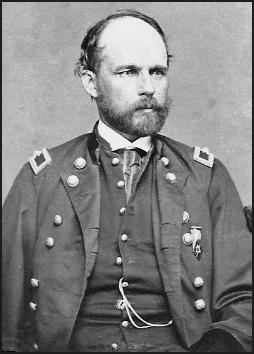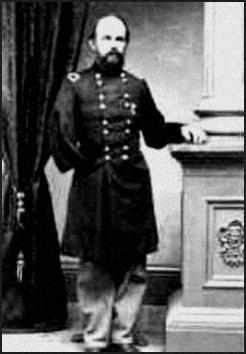George J. Stannard facts for kids
Quick facts for kids
George Jerrison Stannard
|
|
|---|---|

Brig. Gen. George Stannard
|
|
| Born | October 20, 1820 Georgia, Vermont |
| Died | June 1, 1886 (aged 65) Washington, D.C. |
| Place of burial |
Lakeview Cemetery,
Burlington, Vermont |
| Allegiance | United States of America Union |
| Service/ |
United States Army Union Army |
| Years of service | 1861 - 1866 |
| Rank | |
| Commands held | 9th Vermont Infantry 2nd Vermont Brigade |
| Battles/wars | American Civil War |
| Other work | United States Revenue Collector for Vermont |
George Jerrison Stannard (October 20, 1820 – June 1, 1886) was a brave general from Vermont. He fought for the Union during the American Civil War. Before the war, he worked as a farmer, teacher, and government official.
Contents
Early Life and Military Beginnings
George Stannard was born in Georgia, Vermont. He went to public schools there and later attended academies. As a young man, he worked on a farm, taught in schools, and helped run a factory.
Even before the Civil War, George was interested in the military. In 1838, he served as a noncommissioned officer (a leader like a sergeant) in the Vermont militia. Later, in 1856, he helped start a new militia group called the Ransom Guards. He became their first lieutenant. By 1858, he was chosen to lead the 4th Vermont Militia Regiment as a colonel.
Civil War Service
Joining the Fight
When the Civil War began in 1861, George Stannard was one of the first to volunteer. He was elected as a lieutenant colonel (a high-ranking officer) in the 2nd Vermont Volunteer Infantry. He fought in the First Battle of Bull Run in July 1861. His actions were so successful that he was offered command of another regiment, but he felt he hadn't served long enough yet.
During the Peninsula Campaign in 1862, Stannard helped secure a key bridge at the Battle of Williamsburg. This was very important for the battle. Soon after, in July 1862, he was promoted to colonel and given command of the 9th Vermont Infantry.
Harpers Ferry and Promotion
In September 1862, Stannard's regiment was part of the Union forces at Harpers Ferry. They were forced to surrender to Confederate General Stonewall Jackson. Stannard showed great courage during the defense. He even tried to lead his regiment out before the surrender, but he was stopped.
After being released in January 1863, Stannard returned to Vermont. He was promoted to brigadier general (a general who commands a brigade) in March 1863. In April, he took command of the 2nd Vermont Brigade. This brigade included five Vermont regiments. Stannard was known for his calm but effective leadership, which greatly improved the soldiers' spirits.
The Battle of Gettysburg
The Battle of Gettysburg in July 1863 was one of the most important battles of the war. Stannard's 2nd Vermont Brigade marched quickly to join the main Union army. They arrived after the first day of heavy fighting.
On July 2, Stannard's brigade helped recover cannons that had been lost to the Confederates. But their biggest moment came on July 3, during a massive Confederate attack known as Pickett's Charge.
As the Confederate soldiers marched toward the Union lines, Stannard made a brilliant move. He quickly turned two of his regiments (the 13th and 16th Vermont) to the side. This allowed them to fire directly into the flank (side) of the attacking Confederates. This surprise attack caused huge damage and helped stop the charge.
Minutes later, other Confederate brigades attacked nearby. Stannard again wheeled two of his regiments (the 14th and 16th Vermont) to fire into their sides. This tactic helped defeat these attacks too. During this intense fighting, Stannard was wounded in his right leg by an artillery shell. But he bravely stayed on the battlefield until the battle was over.
Major General Winfield S. Hancock, a senior Union commander, praised Stannard's troops. He said they "behaved with spirit" and were "well and vigorously handled." Another general, Abner Doubleday, watched the Vermonters in action and exclaimed, "Glory to God! See the Vermonters go it!" He later wrote that they performed "perhaps the most brilliant feat during the war." He believed they "broke the desperate charge of Pickett, saved the day and with it, the whole North."
Later Service and Injuries
Stannard's leg wound from Gettysburg was severe, so he went back to Vermont to recover. When he returned to duty, he joined the Army of the James. He continued to lead troops in battles like Battle of Cold Harbor and the Second Battle of Petersburg.
During the Siege of Petersburg, Stannard led an attack on Fort Harrison. He was incredibly brave, and his division captured the fort. While defending the captured fort against a Confederate counterattack, he was wounded again. This time, his right arm was so badly injured that it had to be amputated. For his courage at Fort Harrison, he was promoted to major general.
After the War
After losing his arm, George Stannard was assigned to lighter duties in Vermont for the rest of the war. He left the Army in June 1866.
After the war, he worked as a customs official in Vermont. From 1881 until his death, he worked for the Doorkeeper of the United States House of Representatives in Washington, D.C. He passed away in Washington, D.C., and is buried in Lakeview Cemetery in Burlington, Vermont.
A statue of General Stannard stands on the Vermont Memorial at the Gettysburg Battlefield. Another statue of him is in Lakeview Cemetery. The town of Stannard in Vermont was named in his honor.
Images for kids






